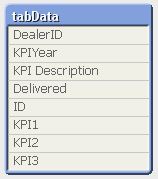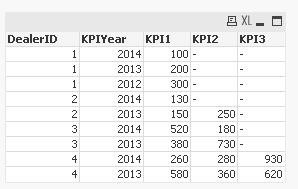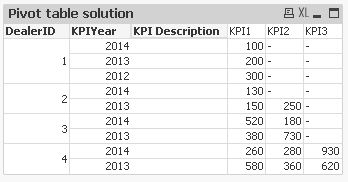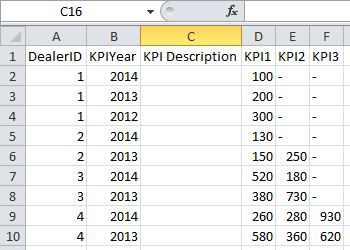Unlock a world of possibilities! Login now and discover the exclusive benefits awaiting you.
- Qlik Community
- :
- All Forums
- :
- QlikView App Dev
- :
- Re: Re: Re: Use field content as name in load
- Subscribe to RSS Feed
- Mark Topic as New
- Mark Topic as Read
- Float this Topic for Current User
- Bookmark
- Subscribe
- Mute
- Printer Friendly Page
- Mark as New
- Bookmark
- Subscribe
- Mute
- Subscribe to RSS Feed
- Permalink
- Report Inappropriate Content
Use field content as name in load
Does anyone have a solution for variable field names, based on table content, in a Load statement?
There are lots of posts on this subject, but I can't find any solutions.
Example, this would be ideal if it worked...
LOAD
DealerID,
KPIYear,
[KPI Description],
Delivered as $([KPI Description])
FROM
$(vQVDPath)\KPDAllDeliveries.qvd (qvd)
Where KPIID='S1';
Regards,
M.
Accepted Solutions
- Mark as New
- Bookmark
- Subscribe
- Mute
- Subscribe to RSS Feed
- Permalink
- Report Inappropriate Content
Hi,
you coud try:
tabDataTemp:
LOAD *,
AutoNumberHash128(DealerID, KPIYear) as ID
INLINE [
DealerID, KPIYear, KPI Description, Delivered
1, 2014, KPI1, 100
1, 2013, KPI1, 200
1, 2012, KPI1, 300
2, 2014, KPI1, 130
2, 2013, KPI1, 150
2, 2013, KPI2, 250
3, 2014, KPI1, 520
3, 2014, KPI2, 180
3, 2013, KPI1, 380
3, 2013, KPI2, 730
4, 2014, KPI1, 260
4, 2014, KPI2, 280
4, 2014, KPI3, 930
4, 2013, KPI1, 580
4, 2013, KPI2, 360
4, 2013, KPI3, 620
];
tabKPI:
Generic LOAD
ID,
[KPI Description],
Delivered
Resident tabDataTemp;
tabData:
LOAD Distinct ID, DealerID, KPIYear Resident tabDataTemp;
DROP Table tabDataTemp;
FOR i = NoOfTables()-1 to 0 STEP -1
LET vTab=TableName($(i));
IF WildMatch('$(vTab)', 'tabKPI.*') THEN
LEFT JOIN (tabData) LOAD * RESIDENT [$(vTab)];
DROP TABLE [$(vTab)];
ENDIF
NEXT i
resulting in only one table:


This script uses code from Rob Wunderlich to combine the seperate tables generated by the generic load into one:
Re: One column with all features (1 feature - 1 row)
There is also one fine post regarding the combination of tables created by a generic load by Henric Cronström:
http://community.qlik.com/blogs/qlikviewdesignblog/2014/03/31/generic
hope this helps
regards
Marco
- Mark as New
- Bookmark
- Subscribe
- Mute
- Subscribe to RSS Feed
- Permalink
- Report Inappropriate Content
use a generic load
- Mark as New
- Bookmark
- Subscribe
- Mute
- Subscribe to RSS Feed
- Permalink
- Report Inappropriate Content
please postr example data
thanks
regards
Marco
- Mark as New
- Bookmark
- Subscribe
- Mute
- Subscribe to RSS Feed
- Permalink
- Report Inappropriate Content
Delivered retruns many rows in accordance with the no of rows in the table which cannot be stoed into a variable.
Try using a peek and get a value out of it to store it into a variable. that should work.
I assume we have the requirend table name in the field Delivered. Please let me know if am wrong or if u need more info.
-sundar
- Mark as New
- Bookmark
- Subscribe
- Mute
- Subscribe to RSS Feed
- Permalink
- Report Inappropriate Content
A sort of working script:
For Loop=1 to 10
Load
10+$(Loop) as $(Loop)
AutoGenerate 1;
Next
Update: Even you can do like:
For Loop=1 to 10
Let vField='Field'&$(Loop);
Load
10+$(Loop) as $(vField)
AutoGenerate 1;
Next
- Mark as New
- Bookmark
- Subscribe
- Mute
- Subscribe to RSS Feed
- Permalink
- Report Inappropriate Content
...and then join them back together.
Is that the most efficient? I need to export the matrix as a txt file.
Regards,
M.
- Mark as New
- Bookmark
- Subscribe
- Mute
- Subscribe to RSS Feed
- Permalink
- Report Inappropriate Content
Hi,
you coud try:
tabDataTemp:
LOAD *,
AutoNumberHash128(DealerID, KPIYear) as ID
INLINE [
DealerID, KPIYear, KPI Description, Delivered
1, 2014, KPI1, 100
1, 2013, KPI1, 200
1, 2012, KPI1, 300
2, 2014, KPI1, 130
2, 2013, KPI1, 150
2, 2013, KPI2, 250
3, 2014, KPI1, 520
3, 2014, KPI2, 180
3, 2013, KPI1, 380
3, 2013, KPI2, 730
4, 2014, KPI1, 260
4, 2014, KPI2, 280
4, 2014, KPI3, 930
4, 2013, KPI1, 580
4, 2013, KPI2, 360
4, 2013, KPI3, 620
];
tabKPI:
Generic LOAD
ID,
[KPI Description],
Delivered
Resident tabDataTemp;
tabData:
LOAD Distinct ID, DealerID, KPIYear Resident tabDataTemp;
DROP Table tabDataTemp;
FOR i = NoOfTables()-1 to 0 STEP -1
LET vTab=TableName($(i));
IF WildMatch('$(vTab)', 'tabKPI.*') THEN
LEFT JOIN (tabData) LOAD * RESIDENT [$(vTab)];
DROP TABLE [$(vTab)];
ENDIF
NEXT i
resulting in only one table:


This script uses code from Rob Wunderlich to combine the seperate tables generated by the generic load into one:
Re: One column with all features (1 feature - 1 row)
There is also one fine post regarding the combination of tables created by a generic load by Henric Cronström:
http://community.qlik.com/blogs/qlikviewdesignblog/2014/03/31/generic
hope this helps
regards
Marco
- Mark as New
- Bookmark
- Subscribe
- Mute
- Subscribe to RSS Feed
- Permalink
- Report Inappropriate Content
on the other hand, you could just create a simple pivot table without any transformation in the script:

and then export to txt from there:


![]()
hope this helps
regards
Marco
- Mark as New
- Bookmark
- Subscribe
- Mute
- Subscribe to RSS Feed
- Permalink
- Report Inappropriate Content
Actually, I have worked out that the best method is to create a pivot chart and then use a
OnPostReload action to export the object using obj.ExportBiff
Thanks to Daniel Viklinder
Regards,
M.